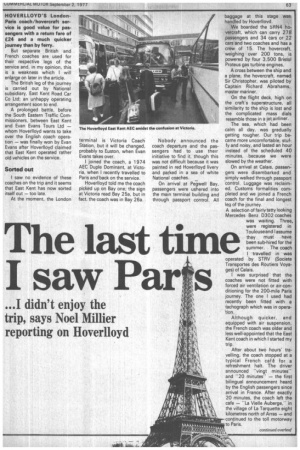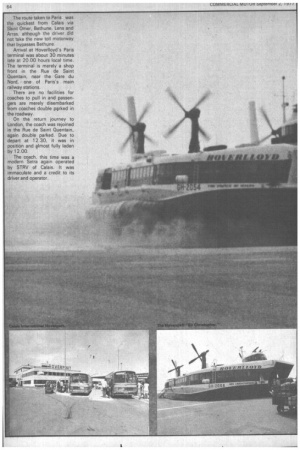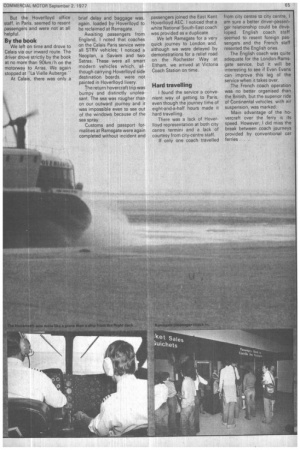The last I saw
Page 65

Page 66

Page 67

If you've noticed an error in this article please click here to report it so we can fix it.
HOVERLLOYD'S LondonParis coach/hovercraft service is good value for passengers with a return fare of £24 and a much quicker journey than by ferry.
But separate British and French coaches are used for their respective legs of the service and, in my opinion, this is a weakness which I will enlarge on later in the article.
the British leg of the journey is carried out by National subsidiary, East Kent Road Car Co Ltd; an unhappy operating arrangement soon to end.
A prolonged battle, before the South Eastern Traffic Commissioners, between East Kent and Evan Evans Tours Ltd — whom Hoverlloyd wants to take over the English coach operation — was finally won by Evan Evans after Hoverlloyd claimed that East Kent operated rather old vehicles on the service.
Sorted out
I saw no evidence of these coaches on the trip and it seems that East Kent has now sorted itself out — too late.
At the moment, the London terminal is Victoria Coach Station, but it will be changed, probably to Euston, when Evan Evans takes over.
I joined the coach, a 1 974 AEC Duple Dominant, at Victoria, when I recently travelled to Paris and' back on the service.
Hoverlloyd told me the coach picked up on Bay one; the sign at Victoria read Bay 25a, but in fact, the coach was in Bay 26a. Nobody announced the coach departure and the passengers had to use their initiative to find it, though this was not difficult because it was painted in red Hovertloyd livery and parked in a sea of white National coaches.
On arrival at Pegwell Bay, passengers were ushered into the main terminal building and through passport control, All baggage at this stage was handled by Hoverlloyd.
We boarded the SRN4 ho vercraft, which can carry 278 passengers and 34 cars or 22 cars and two coaches and has a crew of 15. The hovercraft, weighing over 200 tons, is powered by four 3,500 Bristol Proteus gas turbine engines.
A cross between the ship and a plane, the hovercraft, named Sir Christopher, was piloted by Captain Richard Abrahams, master mariner.
On the flight deck, high on the craft's superstructure, all similarity to the ship is lost and the complicated mass dials resemble those in a jet airliner.
The sea, which had been calm all day, was gradually getting rougher. Our trip became more uncomfortable, stuffy and noisy, and lasted an hour instead of the scheduled 40 minutes, because we were slowed by the weather.
On arrival at Calais, passen gers were disembarked and ,simply walked through passport control. Luggage was reclaimed, Customs formalities completed and we joined a French coach for the final and longest leg of the journey.
A selection of fairly tatty looking
Mercedes Benz 0302 coaches was waiting. Three, were registered in Toulouse and.I assume they must have been sub-hired for the summer. The coach I -travelled in was operated by STRV (Societe Transportes des Routiers Voyages) of Calais.
I was surprised that the coaches were not fitted with forced air ventilation or air-conditioning for the 200-mile Paris journey. The one I used had recently been fitted with a tachograph which was in operation.
Although quicker, and equipped with air suspension, the French coach was older and less well-appointed that the East Kent coach in which I started my trip.
After about two hours' tra velling, the coach stopped at a typical French café for a refreshment halt. The driver announced ''vingt minutes" and "20 minutes" — the first bilingual announcement heard by the English passengers since arrival in France. After exactly 20 minutes, the coach left the cafe — "La Vielle Auberge," in the village of La Tarquette eight kilometres north of Arras — and continued to the toll motorway to Paris.
The route taken to Paris:, was the quickest from Calais via Saint Omer, Bethune, Lens and Arras, although the driver did not take the new toll motorway that bypasses Bethune.
Arrival at Hoverlloyd's Paris terminal was about 30 minutes late at 2000. hours local time. The terminal is merely a shop front in the Rue de Saint Quentain, near the Gare du Nord, one of Paris's main railway stations.
There are no facilities for coaches to pull in and passengers are merely disembarked from coaches double parked in the roadway.
On the return journey to London, the coach was rejoined in the Rue de Saint Quentain, again double parked. Due to depart at 12.30, it was in position and almost fully laden by 12.00.
The coach, this time was a modern Setra again operated by STRV of Calais. It was immaculate and a credit to its driver and operator. But the Hoverlloyd office staff, in Paris, seemed to resent passengers and were not at all helpful
By the book
We left on time and drove to Calais via our inward route. The driver drove strictly by the book at no more than 90krn/h on the motorway to Arras. We again stopped at "l.a VieIle Auberge."
At Calais, there was only a brief delay and baggage was, again, loaded by Hoverlloyd to be reclaimed at Ramsgate.
Awaiting passengers from England, I noted that coaches on the Calais Paris service were all STRV vehicles; I noticed a Neoplan, a Saviem and two Setras. These were all smart modern vehicles which, although carrying Hoverlloyd side destination boards, were not painted in Hoverlloyd livery. the return hovercraft trip was bumpy and distinctly unpleasant. The sea was rougher than on our outward journey and it was impossible even to see out of the windows because of the sea spray.
Customs and passport formalities at Ramsgate were again completed without incident and passengers joined the East Kent Hoverlloyd AEC. I noticed that a white National South-East coach was provided as a duplicate.
We left Ramsgate for a very quick journey to London arid, although we were delayed by demonstrations for a relief road on the Rochester Way at Eltham, we arrived at Victoria Coach Station on time.
Hard travelling
I found the service a convenient way of getting to Paris, even though the journey time of eight-and-a-half hours made it hard travelling.
There was a lack of Hoverlloyd representation at both city centre termini and a lack of courtesy from city-centre staff.
If only one coach travelled from city centre to city centre, I am sure a better driver-passenger relationship could be developed English coach staff seemed to resent foreign passengers and the French staff resented the English ones_ The English coach was quite adequate for the London-Ramsgate service, but it will be interesting to see if Evan Evans can improve this leg of the service when it takes over.
The French coach operation was no better organised than the British, but the superior ride of Continental vehicles, with air suspension, was marked.
Main advantage of the hovercraft over the ferry is its speed. However, I did miss the break between coach journeys provided by conventional car ferries . .




































































































































